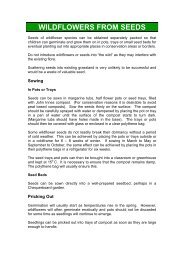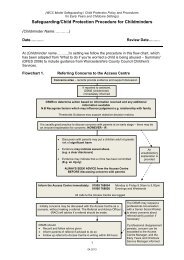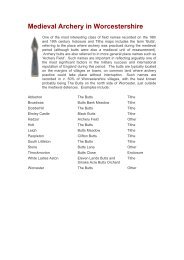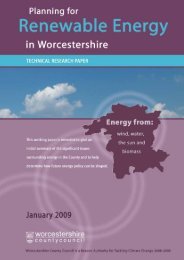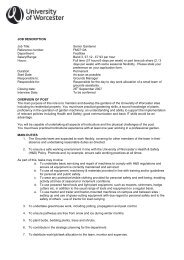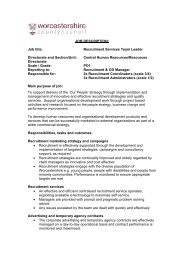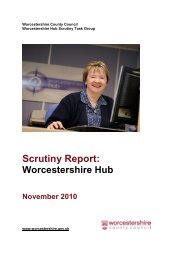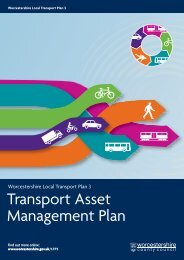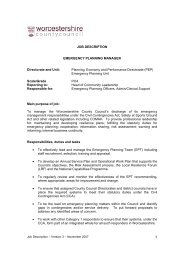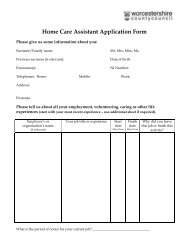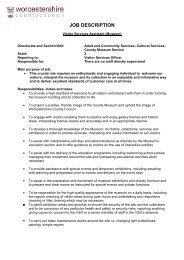Transport Safety Policy - Worcestershire County Council
Transport Safety Policy - Worcestershire County Council
Transport Safety Policy - Worcestershire County Council
Create successful ePaper yourself
Turn your PDF publications into a flip-book with our unique Google optimized e-Paper software.
2.4.6 The Manual for Streets was produced in response to the Governments desire to promoteresidential developments which create more people-orientated streets. Our aim, through theManual, is to reduce the dominance of motor vehicles in residential street design by assigning ahigher priority to the needs of pedestrians and cyclists.2.4.7 A key aim of residential street design should be to naturally encourage low traffic speeds, ideallywithout having to rely on vertical or horizontal deflection measures. The design speed shouldnormally be a maximum of 20 mph. On quieter streets it may be acceptable to omit signs andmarkings indicating priority at junctions. Staggered junctions, compared with crossroads, canreduce vehicle conflict but may reduce directness for pedestrians. Mini and compact roundaboutscan be suitable junctions in residential developments, but larger sizes are generally inappropriate.Junction spacing is usually determined by the size of the blocks of buildings. It tends to reduce asbuilding density and pedestrian activity increase.<strong>Worcestershire</strong> will consider the implementation of 20mph zones in residential areas, whereusers will gain benefit, using the following guidelines:It should be judged likely that, after engineering measures have been installed, the averagespeed will be 20 mph or less at representative sites in the zone, i.e. at individual features andat points between measures where speeds are expected to be highestThe emergency services must be consulted and their responses taken into account whendesigning a 20 mph zone. 20 mph zones are unlikely to be appropriate on the approaches tofire or ambulance stations or hospitals, where the casualty reductions to be expected fromlower speed may be outweighed by the delay to emergency service vehiclesEntrances to 20 mph zones should normally be at a junction so that drivers whosedestination is not within the 20 mph zone have an alternative route outside the zone.Entrances should be designed so as to give the appearance of passing through a ‘gateway’ toa more restricted area.2.4.8 Whilst 59% of the total road casualties in <strong>Worcestershire</strong> result from accidents on our urbannetwork, 52% of those either killed or seriously injured occur on the rural routes. What alsobecomes appreciably noticeable is the fact that two thirds of the killed or seriously injuredcasualties in rural locations result from collisions involving a young driver (17 to 24 yrs). Thispercentage rises to a high as 82% when considering fatally injured casualties only.



